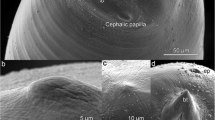Abstract
Three-dimensional observation was carried out on plerocercoids and adults ofDiphyllobothrium dendriticum, D. ditremum, D. latum, andD. vogeli using scanning electron microscopy. The species-specific differences between plerocercoids were recognized in the shapes of the whole body, scolex, and bothrium and the wrinkle pattern on the body surface. The differences between adult worms were also observed in the shapes of the scolex, neck, and genital papillae around the genital pore and the pattern on the egg surface. The significance of species specificity in the three-dimensional morphology of diphyllobothriid cestodes is briefly discussed.
Similar content being viewed by others
References
Andersen K (1972) Studies of the helminth fauna of Norway: XXIV. The morphology ofD. ditremum (Creplin, 1825) from the golden hamster (Mesocrisetus auratus, Waterhouse, 1839) and a comparison withD. dendriticum (Nitzsch, 1824) andD. latum (L., 1758) from the same final host. Norw J Zool 20:255–264
Andersen K (1975a) Comparison of surface topography of three species ofDiphyllobothrium (Cestoda, Pseudophyllidea) by scanning electron microscopy. Int J Parasitol 5:293–300
Andersen K (1975b) The functional morphology of the scolex ofDiphyllobothrium Cobbold (Cestoda,Pseudophyllidea). A scanning electron and light microscopical study on scolices of adultD. dendriticum (Nitzsch),D. latum (L.), andD. ditremum (Creplin). Int J Parasitol 5:487–493
Andersen K (1977) A marineDiphyllobothrium plerocercold (Cestoda,Pseudophyllidea) from blue whiting (Micromestius poutasson). Z Parasitenkd 52:289–296
Berger J, Mettrick DF (1971) Microtrichial polymorphism among hymenolepid tapeworms as seen by scanning electron microscopy. Trans Am Microsc Soc 90:383–403
Bylund G (1975a) Delimitation and characterization of EuropeanDiphyllobothrium species. Academic Dissertation. Department of Biology, Åbo Academy, Åbo, Finland pp 1–23
Bylund G (1975b) Studies on the taxonomic status and biology ofDiphyllobothrium vogeli Kuhlow, 1953. Commental Biol Soc Sci Fenn 79:1–22
Halyorsen O (1970) Studies of the helminth fauna of Norway: XV. On the taxonomy and biology of plerocercoids ofDiphyllobothrium Cobbold, 1858 (Cestoda,Pseudophyllidea) from North-Western Europe. Nytt Mag Zool 18:113–174
Hilliard DK (1972) Studies on the helminth fauna of Alaska: LI. Observations on eggshell formation in some diphyllobothriid cestodes. Can J Zool 50:585–592
Ubelaker JE, Allison VF, Specian RD (1973) Surface topography ofHymenolepis diminuta by scanning electron microscopy. 59: 667–671
Yamane Y, Maejima J, Kamo H (1974) Study ofSptrometra erinacei (Rudolphi, 1819) Faust, Campbell and Kellogg, 1929, through scanning electron microscope. Yonago Acta Med 18:84–93
Yamane Y, Maejima J, Yazaki S (1975) Scanning electron microscopic observation of the tegumental structure of diphyllobothriid cestodes. Yonago Acta Med 19:97–206
Yamane Y, Yoshida N, Yazaki S, Maejima J (1978) Observations on the ultrastructure of the excretory canal of the cestode,Spirometra erinacei. Shimane J Med Sci 2:1–14
Author information
Authors and Affiliations
Rights and permissions
About this article
Cite this article
Yamane, Y., Bylund, G., Abe, K. et al. Scanning electron microscopic study of fourDiphyllobothrium species. Parasitol Res 75, 238–244 (1989). https://doi.org/10.1007/BF00931282
Accepted:
Issue Date:
DOI: https://doi.org/10.1007/BF00931282




